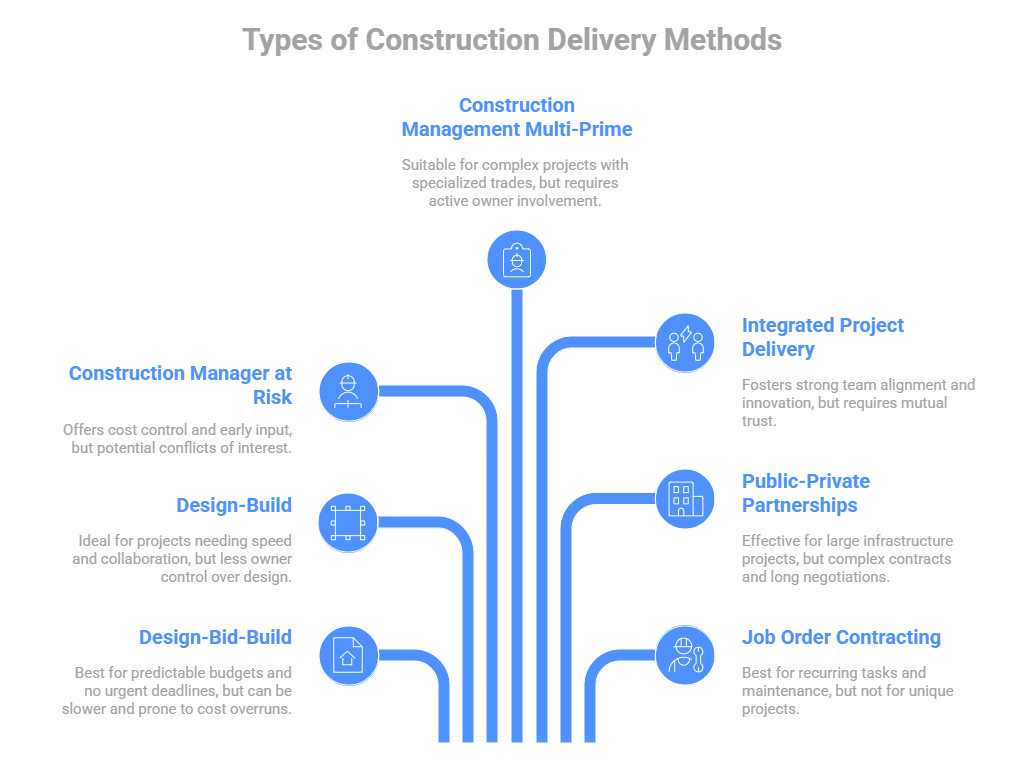Every successful building begins with a solid plan, a skilled team, and a method for turning vision into reality. A brilliant design or a strong team isn’t enough if the project delivery approach isn’t aligned with your goals, budget, and timeline. This is where construction delivery methods come into play.
Your delivery method determines who is responsible for what, how risks are shared, the flow of communication, and how quickly the project gets completed. With so much riding on this choice, understanding your options is critical.
Think of Construction Delivery methods as the “game plan” for how a project will move from an idea on paper to a complete capital project. The decisions you make can determine how risks are handled, how teams collaborate, and how much control you have over costs and schedules.
In this blog, we will explore what construction delivery methods are, the pros and cons of 7 widely used approaches, and tips on how to choose the best one for your large or small-scale capital project.
What Are Construction Delivery Methods?
Construction delivery methods are standardized approaches that define the contractual relationships and a basic set of workflows among all the parties involved in a capital project.
They answer the big questions:
Who designs? Who built it? How are contracts handled? Who bears the risk if things go sideways?
By clarifying these kinds of roles and structures, delivering methods shape every aspect of your project, from communication patterns to timelines, budget, and successful project completion.
Selecting the proper construction delivery method is all about matching your unique project requirements, resources, and goals with the framework best equipped to deliver results. No single method fits all, and each comes with distinct advantages and possible pitfalls.
Types of Construction Delivery Methods (Pros and Cons of each method)

Selecting the right delivery methods can make or ruin the capital project, from collaboration and timelines to cost and accountability. Therefore, every method offers a unique specification to manage design, construction, risk, and communication. Let’s break down the seven most common construction delivery methods, their advantages, and potential drawbacks:
1. Design-Bid-Build (DBB)
This traditional DBB method of the construction delivery system is executed in three steps, which include completing the plans by the designer, submitting bids by the contractors, and the contract being awarded to the lowest bidder.
It provides separation of roles and competitiveness in prices, which is another reassurance to many owners. However, the schedules may get stretched as construction will only start after the designs are completed. It is even susceptible to cost overruns if design errors are discovered during construction.
Pro:
- Familiar and widely understood by all industry players.
- Competitive bidding can lead to lower initial construction costs.
- There should be a clear separation between design and construction responsibilities.
Cons:
- The timeline is longer because construction can’t start until the design is complete.
- Limited collaboration between the designer and builder can lead to misunderstandings.
- Cost overruns are possible if design errors are found during construction.
Best for: Projects with easy-to-use navigation, predictable budgets, and no urgent deadline pressures.
2. Design-Build (DB)
In this, the design and building construction come under one roof. Generally, a single company manages both. As a construction delivery method, it enables seamless communication and often reduces schedules by overlapping design and build phases.
A single point of responsibility also reduces disputes. On the other side, owners may lose some design control and must trust the design-build team completely.
Pro:
- Quicker execution due to overlapping timelines in design and build phases.
- The ownership has one point of accountability, which relieves the owner.
- Innovation and cost savings can result from the collaboration.
Cons:
- Less owner control over design details.
- More difficult to compare costs across multiple bids.
- The quality may differ according to the expertise of the design-builder.
Best For: Projects needing speed or those open to integrated, collaborative solutions.
3. Construction Manager at Risk (CMAR)
This delivery method brings in a construction manager early, even during design, and the manager commits to a Guaranteed Maximum Price (GMP). Among construction delivery methods, CMAR offers a great extent of cost control and early input on constructability.
Owners benefit from expertise on schedule and budget before breaking ground. However, there is the possibility of conflict as the Construction Manager is simultaneously an advisor to the owner and the contractor who will carry out the work, and this may lead to a conflict of interest.
Pros:
- Early input from the builder can prevent design mistakes.
- CM helps keep the project within budget.
- Flexibility to start construction before drawings are 100% complete.
Cons:
- You may not get the lowest price (no competitive bid).
- Possible conflicts of interest if the CM’s financial interests aren’t aligned.
- Transparency relies on trust and clear contracts.
Best For: Complex projects require close coordination and early contractor involvement.
4. Construction Management Multi-Prime (CMMP)
With CMMP, the owner takes on a hands-on role by holding multiple prime contracts, for example, separate contracts for electrical, plumbing, and structural work, with a construction manager acting as an advisor. As a construction delivery method, it allows targeted expert teams and competitive pricing per trade. Yet, it’s administration-heavy and coordination-intensive, demanding more oversight from the owner.
Pros:
- Direct contracts can save money (no general contractor markup).
- The owner retains control.
- Works well for complex jobs with lots of specialized trades.
Cons:
- The owner assumes more risk and must be actively involved.
- It can lead to coordination headaches.
- Disputes between prime contractors can delay progress.
Best For: Experienced owners are comfortable managing many moving parts and contracts.
5. Integrated Project Delivery (IPD)
IPD stands out among construction delivery methods for its collaborative ethos, where owners, designers, and contractors join under one contract, sharing risks, rewards, and decision-making.
This tight integration drives innovation, early problem-solving, and better alignment. But cultivating trust and navigating complex shared contracts can be challenging, making it a fit mainly for teams ready for that collaborative leap.
Pros:
- Strong team alignment, with everyone pulling in the same direction.
- Shared financial incentives foster trust and problem-solving.
- Can result in cost savings, fewer disputes, and better outcomes.
Cons:
- Requires a cultural shift and mutual trust.
- Legal frameworks can be complex.
- Not all teams adapt well to complete transparency.
Best For: Innovative or high-stakes projects where the owner values maximum collaboration and is willing to experiment.
6. Public-Private Partnerships (PPP or P3)
A P3 is a pact where a private entity designs, builds, and often operates a public project under a long-term agreement. This construction delivery method brings private-sector efficiency and funding to public infrastructure, helping projects proceed without immediate public capital. It’s powerful for large builds, yet contracts are intricate, negotiations are lengthy, and long-term costs can exceed traditional delivery.
Pros:
- It helps reduce the financial burden on public agencies.
- It allows private sector efficiency and innovation in the public sector.
- It can accelerate the delivery of large-scale infrastructure.
Cons:
- Complex contracts and long negotiation periods.
- Public accountability can be challenging.
- Long-term costs may be higher than traditional delivery.
Best for: Large-scale infrastructure projects like highways, schools, or hospitals.
7. Job Order Contracting (JOC)
Job Order Contracting is customized for repeated or smaller tasks. The owner contracts a provider based on preset tasks, ideal for maintenance or renovations. As a construction delivery method, it speeds procurement and reduces paperwork while fostering familiarity with the contractors. It is not suited for one-off, complex projects, though, and differences between estimated and actual costing can lead to disputes.
Pros:
- Fast procurement for recurring work.
- Reduces administrative burden.
- Strong relationships can form between the owner and the contractor.
Cons:
- Not suitable for large, unique projects.
- Requires an accurate unit price catalog to avoid disputes.
- Less competitive pricing for one-off, high-value projects.
Best for: Maintenance, renovations, and ongoing facility improvements.
How to Choose the Right Delivery Method?
With various options for construction delivery methods available, choosing the suitable one for your unique capital project is a difficult task. So, how do you choose one for your capital project? Here is the step-by-step guide for you to help your section process easily:
- Project complexity: If the project involves advanced engineering or needs early detection or challenges and solving them in a timely manner, then collaborative methods like IPC or CMAR can be beneficial.
- Timeline: If the capital project needs to be completed on a priority basis, the design-build or JOC delivery method can help fast-track the project completion.
- Budget: Methods with guaranteed pricing, like CMAR or DBB, will provide more control over the cost.
- Risk: IPD shares risk among all the parties, while DBB places much of the risk on the contractor.
Conclusion
Each capital project is unique with its set of targets, challenges, and limitations. The use of corresponding construction delivery methods can predetermine the efficient delivery of such goals. Whether it is the predictability of DBB or the teamwork of IPD, all the construction delivery methods have both benefits and trade-offs. By understanding the strengths as well as the weaknesses of a given method, it will save a lot of budget, time, and energy. Hence, assists in staying on track with the vision of one’s project.
However, the most significant option is to align your needs to your preferences in terms of budget, speed, quality, and risk management with the way the delivery approach is structured. If you are stuck in choosing the suitable methods, reach out to OnIndus, who understand the pros and cons of each approach.
FAQs
1. What is the best construction delivery method?
It is not about one being the best method- entirely dependent on the requirements of the project i.e., goal of the project, budget, complexity, and deadline of project submission. Collaborative approaches, such as Integrated Project Delivery (IPD), are suitable where complicated builds are involved, and Design-Bid-Build is predictable. The most appropriate option should be the one that optimizes the cost with risk distribution and the preferred amount of owner participation.
2. Which is the most common delivery method in the construction industry?
The most used delivery method is the Design-Bid-Build (DBB). It has a step-by-step approach, i.e., design, bidding, and construction; clear roles and a competitive price. This classical method is popular enough to be utilized regularly within the occupational field, and it is an ideal solution to simple projects with a clear budget and schedule.
3. Which delivery method is best for fast-track projects?
Fast-track projects are frequently best constructed by Design-Build. The overall process is more efficient since there is less time mediating between design and construction because the two take place concurrently under the same contract, enhancing communication. This overlap accelerates delivery and at the same time ensures there is accountability, therefore making an ideal asset in an event where hitting a strict deadline is of utmost priority.
4. What is the PPP delivery method?
Public-Private Partnerships (PPP or P3) are an arrangement through which a private party funds, designs, constructs, and possibly operates a public project, whether that project is infrastructure or facilities. Individually, the private participant is paid or earns the revenue rights in exchange for a stipulated duration. The approach is a combination of both the social demands and the efficiency and funding by the private sector.
5. Which method gives owners the most control?
Construction Management Multi-Prime (CMMP) grants the maximum control to owners. Owners can directly hire and supervise every trade by having individual contracts with different prime contractors. Although it is flexible and makes decision-making easier, it necessitates serious coordination and skills to be able to handle it properly.

